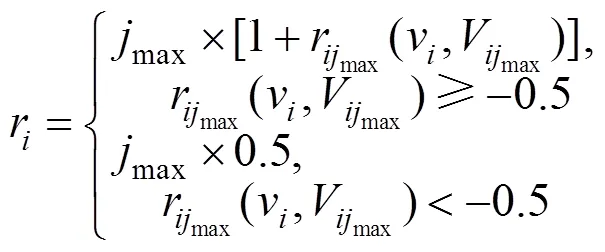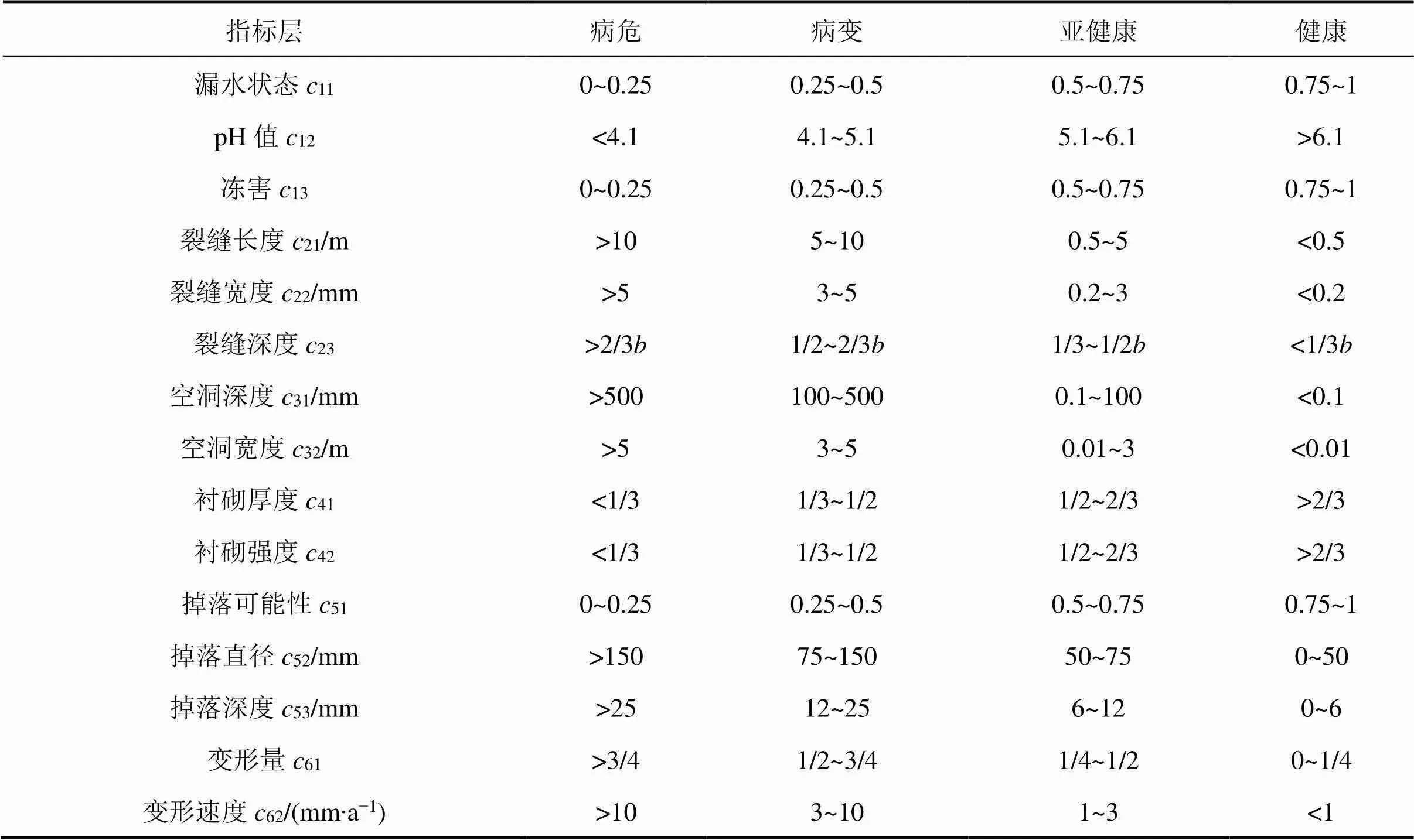可拓法评估运营隧道衬砌结构健康实例
安永林,李佳豪,赵丹,张运良,杨高尚
可拓法评估运营隧道衬砌结构健康实例
安永林1, 2,李佳豪2,赵丹3,张运良4,杨高尚4
(1. 湖南科技大学 岩土工程稳定控制与健康监测省重点实验室,湖南 湘潭 411201;2. 湖南科技大学 土木工程学院,湖南 湘潭 411201;3. 长沙市轨道交通集团有限公司,湖南 长沙 410000;4. 中南大学 土木工程学院,湖南 长沙 410075)
为综合评价服役隧道结构健康状况,构建隧道结构健康状况多级可拓评估模型与计算流程,以某隧道某断面病害检测为实例,给出分级标准与评价指标体系,并对评价指标的相关检测量值进行归一化处理后,评估该断面的结构健康等级。研究结果表明:该断面的隧道结构健康等级属于亚健康,需要进行维修加固;并获得各准则层的病害等级,如衬砌变形和空洞对隧道健康影响等级是病害等级,渗漏水和裂缝为亚健康等级。从而可以有针对性地采取不同的加固策略,如渗漏水采用注浆或者引排,裂缝采用修补或者注浆+锚杆等,脱空采用注浆或回填等。
隧道工程;健康检测;结构健康评估;可拓评估

我国已运营隧道由于服役多年,出现不同程度的病害,影响到自身结构的健康状况,目前很多学者做了相关的研究:分析水下隧道的健康状况[1];研究隧道坡度对衬砌裂缝的影响机制[2];通过深度学习法判断裂缝与渗漏水位置[3];讨论了水下TBM隧道的健康监测[4];基于不同的裂缝宽度评估隧道衬砌安全性[5];基于小波分析识别衬砌损伤位置[6];分析空洞不同位置对砌体隧道的安全影响[7−8];层状隧道病害机理分析[9];基于云模型与模糊数学的健康综合评估[10−12]。XU等[1−8]侧重于隧道某一病害的分析,缺少对隧道健康的整体评估;而王亚琼 等[11−12]在整体评估中,对于指标权重的确定以及隶属度函数、云函数的确定存在主观性。为此,本文首先构建多级可拓评估法评估隧道健康模型,避免权重的主观性,然后结合一实际运营隧道检测数据,给出相应的评估实例与整治措施。
1 多级可拓法评价隧道结构健康
1.1 多级可拓法评价隧道结构健康流程
见图1[13]。

图1 多级可拓法评估隧道结构健康状况的流程
1.2 构建多级可拓法评估隧道结构健康模型
1.2.1 确定经典域、节域[13]
隧道结构健康状况级别的经典域如下:


式中:N为第级健康状况,=1,2,…,;c为健康状况级别u评判指标,=1,2,…,;kj为j关于健康评价指标c对应的量值范围。
节域如下:


式中:为健康状况级别的全体;V为关于c所取的量值范围,即的节域〈a,b〉。
1.2.2 确定待评隧道结构健康状况模型
用物元表示:

式中:为待评隧道结构健康状况;V为待评隧道结构健康状况,对应的c的量值。
1.2.3 隧道结构健康状况的多级可拓模型
将物元=[,,]可拓为:
=[,,]−|{[1,1,1],[2,2,2],…,[R,C,V],…,
[R,C,V]} s.t.=1∪2∪…∪i∪…∪n,

式中:{1,2,…,R,…,R}为的隧道结构健康状况子集;为划分隧道结构健康状况子集的个数。
此时最底层健康状况的待评物元模型为:

1.2.4 计算底层健康状况R等级的关联函数值
设0实数域(−∞, +∞)上任意一点,0=(,)为实数域上任意一区间,(0,0)为点0与区间0之距,则:

初等关联函数为:

则待评健康状况R关于各健康状况级别的关联函数值为:

1.2.5 评估底层健康状况R


若

则底层健康状况R属于等级0。
令


称*为隧道结构健康等级的变量特征值。
1.2.6 多级可拓法评估隧道结构健康
隧道结构健康状况评判变换矩阵为:



同理,根据公式(5-9)~(5-11),可得隧道结构健康状况的综合评估等级0与级别变量特征值*。
1.2.7 指标层和准则层权重确定
设

式中:=1,2,…,;=1,2,…,。

若分级指标c值越大,其权重越大,则

若分级指标c值越大,其权重越小,则

分级指标c权重

2 隧道结构健康状况评价实例
2.1 隧道结构健康状况评价等级划分
隧道结构健康分级见表1、评价指标体系与分级标准件表2和表3[10−12]。
对于定性的指标,如表5中的漏水状态、冻害等,则根据其影响隧道结构安全及形成安全的程度进行打分:0~0.25为病危,0.25~0.5为病变,0.5~0.75为亚健康,0.75~1为健康。
若隧道结构健康检测中,未检测到或检测项目比上述多,可根据实际情况增加或减少评价指标。
其中衬砌厚度指标41为实测量值与设计量值之比;衬砌强度指标42为实测强度量值/设计强度量值之比;变形量指标61为变形量实测值与内限距之比。

表1 隧道结构健康等级

表2 隧道结构健康状况评价指标体系
2.2 现场病害检测情况
湖南长沙蕉溪岭运营隧道病害现场检测见图2。

表3 公路隧道结构健康评价指标的分级标准

(a) 裂缝宽度观测;(b) 二次衬砌厚度探测;(c) 二次衬砌强度检测;(d) 断面检测
2.3 隧道病害检测值与归一化处理
以湖南长沙蕉溪岭隧道的病害检测为例。蕉溪岭隧道在319国道上,由1号~3号3座隧道组成,全长3 900 m, 1996年10月交工验收并运营。k55+ 973处病害检测值见表4[14],归一化处理结果见表5。

表4 蕉溪岭隧道结构健康检测指标值
注:“—”表示该项未检测。

表5 隧道结构健康状况评价指标归一化处理
2.4 评价各准则层的风险
对于准则层中的衬砌裂缝2,其经典域和节域如下:

其中:=1, 2, 3, 4。当=1时,21,22的量值范围<211,211>,<221,221>分别取<0, 0.339>,<0, 0.751>。
可以得到衬砌裂缝的同征物元如下:

指标权重:
2i=[0.457 3 0.542 7]
衬砌裂缝关于健康等级的关联度:
2i()=[−0.608 3 −0.278 4 0.295 4 −0.479 2]
根据上述理论,可以得到衬砌裂缝等级10=3,为“亚健康”;并且可以得到衬砌裂缝等级的变量特征值1*=2.85,表示在该段的对于衬砌裂缝,其健康等级属于“亚健康”级别偏向“病害”的级别(严格说来应属于2.85级健康)。
同理,可以得到,隧道渗漏水的关联度:
1i()=[−0.600 0 −0.400 0 0.200 0 −0.142 9]
渗漏水对隧道结构健康影响等级10=3,为亚健康。
衬砌背后空洞的关联度:
3i()=[−0.246 8 0.441 7 −0.301 2 −0.499 8]
衬砌背后空洞对隧道结构健康影响等级30=2,为病害等级。
材料劣化的关联度:
4i()=[−0.849 5 −0.798 4 −0.694 5 0.305 5]
材料劣化对隧道结构健康影响等级40=4,为健康等级。
衬砌变形的关联度:
5i()=[−0.142 9 0.200 0 −0.400 0 −0.600 0]
衬砌变形对隧道结构健康影响等级50=2,为病害等级。
2.5 评价目标层的风险
对于各准则层的权重,由层次分析法AHP确定,具体如下表所示,而=0.05<0.1,满足一致性检验要求。
()=[−0.538 0 −0.2543 0.012 0 −0.314 3]
隧道结构健康等级0=3,为亚健康等级,健康等级的变量特征值*=2.9,表示在该段的健康综合评价等级属于“亚健康”级别偏向“病害”的级别(严格说来应属于2.9级健康)。
根据上述目标层和准则层的评估结果,即可有针对性的采取不同的加固策略,方便了隧道结构的健康评估及病害维修加固。本文依托的蕉溪岭隧道病害的具体整治措施,见本项目组研究团队的研究报告以及学位论文(文献[14]);治理方案也将在后续文章中做探讨,渗漏水采用注浆或者引排;裂缝采用修补或者注浆+锚杆等;脱空采用注浆或回填等。

表6 准则层的权重
3 结论
1) 构建了多级可拓法评估隧道结构健康模型,给出了评估的流程及建立过程。
2) 隧道在该断面处的结构的健康等级为3级,属于亚健康,需要进行维修加固。获得了各准则层的病害等级,如衬砌变形和空洞对隧道健康影响等级是病害等级,渗漏水和裂缝为亚健康等级。
3) 根据评估结果,可以有针对性的采取不同的加固策略,方便了隧道结构的健康评估及病害维修加固,如渗漏水采用注浆或者引排;裂缝采用修补或者注浆+锚杆等;脱空采用注浆或回填等。
[1] XU Xiangchun, TONG Liyuan, LIU Songyu, et al. Evaluation model for immersed tunnel health state: A case study of Honggu Tunnel, Jiangxi Province, China[J]. Tunnelling and Underground Space Technology, 2019, 90: 239−248.
[2] Chiu Y C, Lee C H, WANG T T. Lining crack evolution of an operational tunnel influenced by slope instability[J]. Tunnelling and Underground Space Technology, 2017, 65: 167−178.
[3] HUANG Hongwei, LI Qingtong, ZHANG Dongming. Deep learning based image recognition for crack and leakage defects of metro shield tunnel[J]. Tunnelling and Underground Space Technology, 2018, 77: 166−176.
[4] YANG Jianping, CHEN Weizhong, LI Ming, et al. Structural health monitoring and analysis of an underwater TBM tunnel[J]. Tunnelling and Underground Space Technology, 2018, 82: 235−247.
[5] JIANG Yujing, ZHANG Xuepeng, Tetsuya taniguchi. Quantitative condition inspection and assessment of tunnel lining[J]. Automation in Construction, 2019, 102(6): 258−269
[6] WANG Shengnan, LI Jun, LUO Hui, et al. Damage identification in underground tunnel structures with wavelet based residual force vector[J]. Engineering Structures, 2019, 178: 506−520.
[7] 王薇, 邓俊, 姚勇, 等. 砌石铁路隧道典型病害下安全性研究[J]. 铁道科学与工程学报, 2016, 13(1): 131− 137. WANG Wei, DENG Jun, YAO Yong, et al. Safety research of masonry railway tunnel under typical disease[J]. Journal of Railway Science and Engineering, 2016, 13(1): 131−137.
[8] 王春景, 雷明锋, 彭立敏. 病害隧道结构安全性评价模型与方法[J]. 铁道科学与工程学报, 2011, 8(3): 73−77. WANG Chunjing, LEI Mingfeng, PENG Limin. Safety evaluation model and method of tunnel disease sturcture[J]. Journal of Railway Science and Engineering, 2011, 8(3): 73−77.
[9] 温建永. 层状岩体隧道病害机理分析及整治措施研究[J]. 铁道科学与工程学报, 2017, 14(5): 1024−1028. WEN Jianyong. Research on the damage of structure and its treatment for a tunnel constructed in interbedded rock mass[J]. Journal of Railway Science and Engineering, 2017, 14(5): 1024−1028.
[10] 吴贤国, 覃亚伟, 沈梅芳, 等. 基于云推理的运营隧道结构健康安全风险评价研究[J]. 中国安全科学学报, 2017, 27(2): 133−138. WU Xianguo, QIN Yawei, SHEN Meifang, et al. Research on health and safety risk assessment of operational tunnels based on cloud reasoning[J]. China Safety Science Journal, 2017, 27(2): 133−138.
[11] 王亚琼, 周绍文, 孙铁军, 等. 基于模糊贴近度的公路隧道结构健康评价[J]. 公路交通科技, 2014, 31(12): 78−83. WANG Yaqiong, ZHOU Shaowen, SUN Tiejun, et al. Structural health assessment for highway tunnels based on fuzzy proximity[J]. Journal of Highway and Transportation Research and Development, 2014, 31(12): 78−83.
[12] 韩常领, 夏才初, 卞跃威, 等. 六甲洞隧道健康状态的模糊综合评价[J]. 公路, 2008, 53(7): 250−254. HAN Changling, XIA Caichu, BIAN Yuewei, et al. Structural health assessment for Liujiadong tunnels based on fuzzy model[J]. Highway, 2008, 53(7): 250−254.
[13] 安永林, 彭立敏, 吴波, 等. 隧道坍方突发性事件风险可拓法综合评估[J]. 中南大学学报(自然科学版), 2011, 42(2): 514−520. AN Yonglin, PENG Limin, WU Bo, et al. Comprehensive extension assessment on tunnel collapse risk[J]. Journal of Central South University (Science and Technology), 2011, 42(2): 514−520.
[14] 王春景. 运营公路隧道结构病害安全性评估及综合处治技术研究[D]. 长沙: 中南大学, 2010. WANG Chunjing. Study on assessment and comprehensive treatment of road tunnel disease[D]. Changsha: Central South University, 2010.
Comprehensive extension assessment on tunnel structure health
AN Yonglin1,2, LI Jiahao2, ZHAO Dan3, ZHANG Yunliang4, YANG Gaoshang4
(1.Hunan Provincial Key Laboratory of Geotechnical Engineering for Stability Control and Health Monitoring, Hunan University of Science and Technology, Xiangtan 411201, China;2. School of Civil Engineering, Hunan University of Science and Technology, Xiangtan 411201,China; 3. Changsha Metro Group Co., Ltd, Changsha 410000,China;4. School of Civil Engineering, Central South University, Changsha 410075, China)
In order to evaluate the health condition of the tunnel, the multi-level extension assessment model and calculation process of tunnel structure health were constructed. Taking distress detection of a tunnel section as an example, the classification criteria and evaluation index system were given. The structural health grade of the section was evaluated after normalizing the relevant detection values of the evaluation indices. The results show that the health level of tunnel structure in this section that belongs to sub-health and need to be repaired. The distress grade of each criterion layer was obtained. The influence of lining deformation and cavity on the health of the tunnel is the level of damage and the influence of seepage water, and cracking is the sub health level. Therefore, it can take different reinforcement strategies, for instance, grouting or drainage for seepage; repairing or grouting with bolts for cracks, grouting or backfilling for void, etc.
tunnel engineering; structure health monitoring; structure health assessment; extension assessment
U459.2
A
1672 − 7029(2020)02 − 0422 − 07
10.19713/j.cnki.43−1423/u.T20190361
2019−04−29
国家自然科学基金资助项目(51408216,51308209);湖南省学位与研究生教育教学改革研究项目;湖南科技大学研究生培养改革研究项目(J151101)
安永林(1981−),男,安徽寿县人,副教授,博士,从事隧道与地下工程研究;E−mail:aylcsu@163.com
(编辑 涂鹏)

